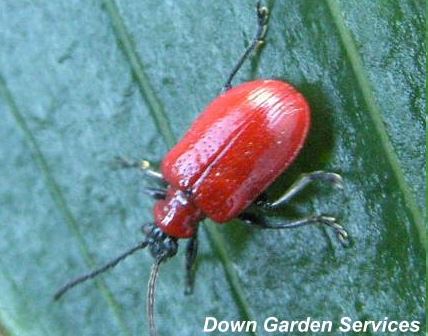
The bright red body, black legs and head make Red Lily Beetles very striking in appearance, but these little beasts are very destructive to bulbous plants and in particular Lilium such as Turk's cap lilies, Asiatic lilies, Oriental lilies and Tiger lilies also some Fritillaria species. As with most destructive invertebrates it is the larval stage that does most on the damage.
From spring to autumn the beetles and larvae feed on the foliage, flowers and stems. The removal of the leaves deprives the plant of food production which severely weakens it and may prevent flowering the following year, or in severe cases kill the plant.
The Lily Beetle is native to mainland Europe and Asia, but not the British Isles. First reported in Southern England in the nineteenth century, it is believed that they did not become established until the 1940s. They had been confined to the south, but the recent increase in average temperatures has allowed them to move northward, and some of the specimens pictured here were found in a garden near Newtownards, County Down in October 2006 - the first reported find in Northern Ireland was in a garden in Belfast in June 2002. Since then the numbers have rocketed and in summer 2010 I squashed dozens of them; the extremely low temperatures in December 2010 and January 2011 do not seem to have caused them any problems as I have already found several while doing spring tidy-ups in 2011 - temperatures down to -18°C were recorded locally. So these must be a more resilient variant or the notion that our lower temperatures had prevented them being here in earlier times, was incorrect.
They have also moved to North America, first reported in Canada in 1945 and now spreading south in the eastern states of USA.
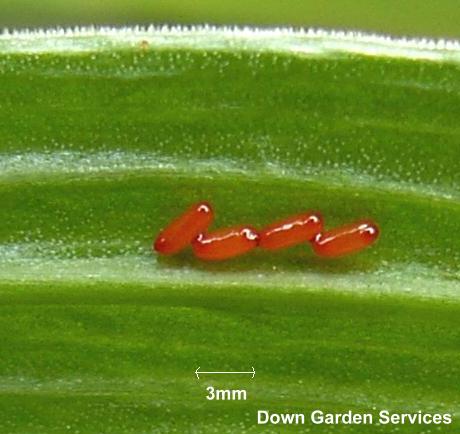 Bright orange lily beetle eggs, usually a few on the underside of a number of leaves. | 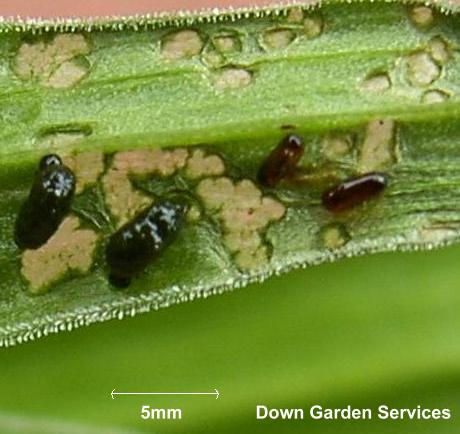 Two first instar larvae (left) eating the lower layers of leaf cells, and two eggs (right). Even at this early stage they are covered with black goo. |
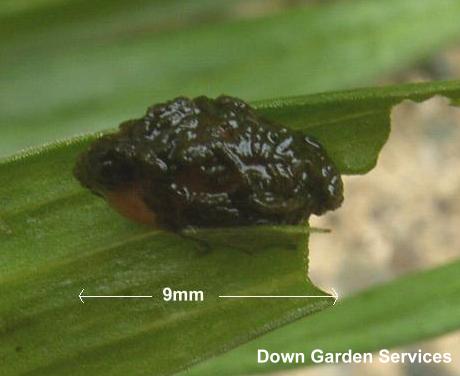 A larva with its coat of sticky excrement | 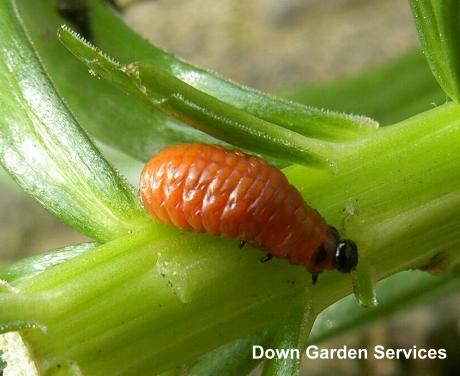 A 'naked' specimen, which is similar to the larva of the Colorado Beetle, but the latter has black spots along its sides. |
The adults have been found on other plants including Lily of the Valley, Soloman's seal and Day Lilies. The larvae have only been found on bulbous Lilies and Fritillaries.
TreatmentsThe beetles make holes and notches on the upper foliage which is an indicator that the whole plant should be examined, although in this case a beetle is in clear view. There were also eggs present when the undersides of the leaves were checked - three or four on each of several leaves. The recommended method of removal is to check affected plants regularly picking off and crushing any beetles, eggs or larvae. The beetles tend to drop to the ground when the plant is disturbed with their black undersides showing, so they are easier to find if a light-coloured material is placed there first. Approach from below and lift the leaf, trapping the beetle against the stem. The beetles can fly in at any time so regular checks are required as they seem to be endemic all over the British Isles now. There are a few preventative measures which can be taken, such as checking new bulbs for larvae before planting. Probably the most likely method of spread is the recent trend of buying established lilies in pots. *Imidacloprid is a neonicotinoid compound and these have been suggested as as causative agents of colony collapse disorder (CCD) in Honeybees. It is currently banned in EU countries so insecticides have been reformulated to take this into account. |
Back to GARDEN CREATURES